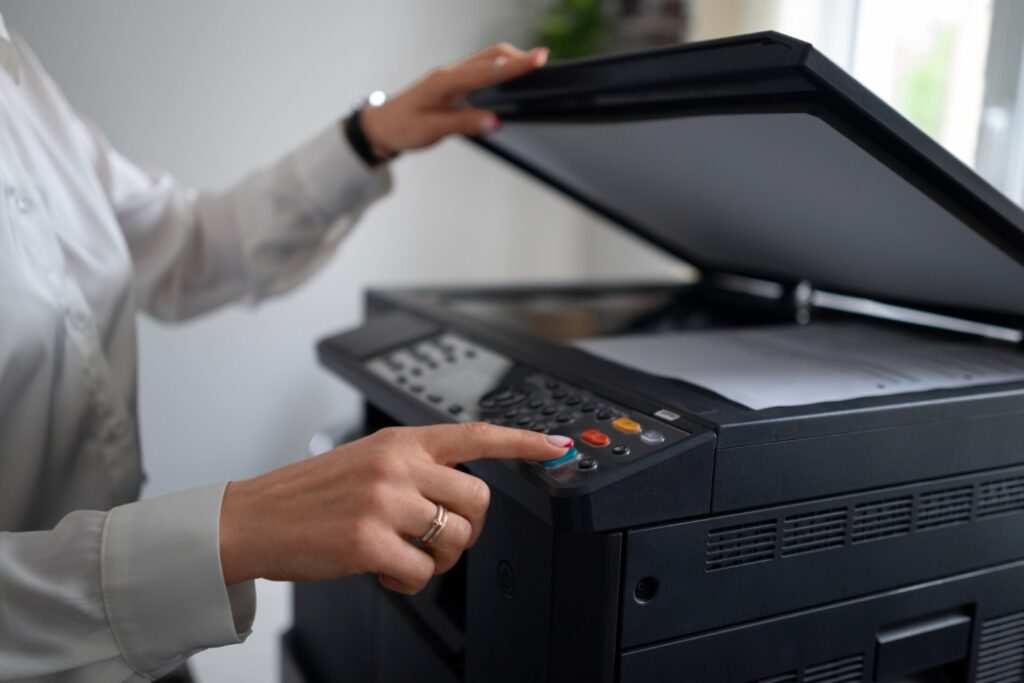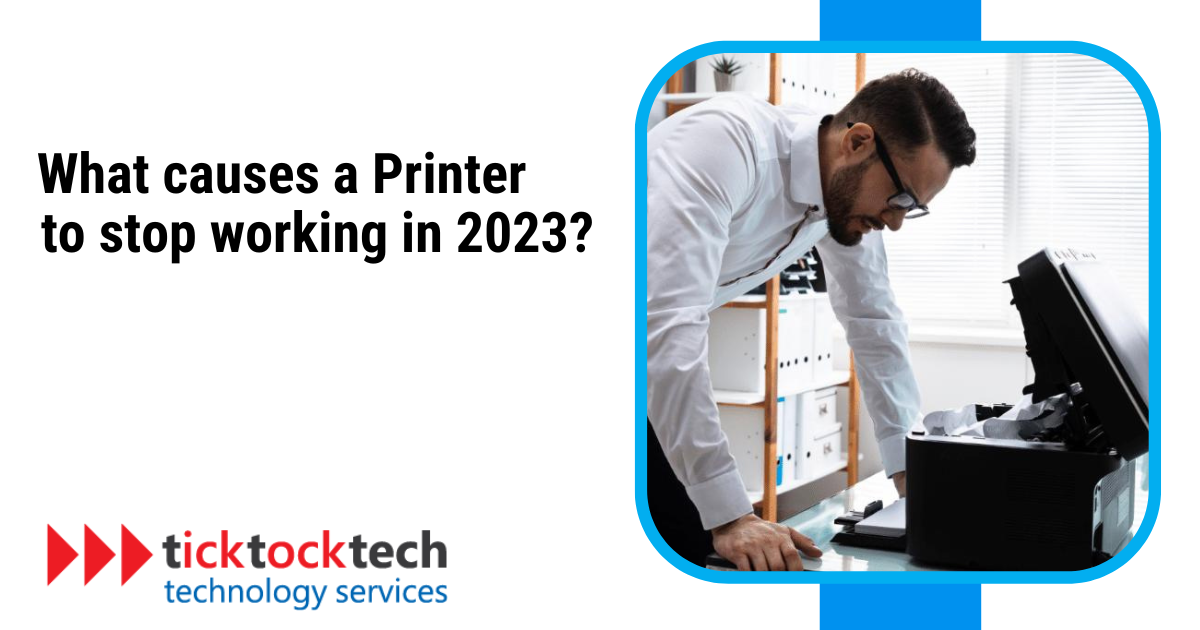If you’re wondering what could be causing your printer to stop working, you’re at the right place.
In this blog post, we will discuss the most common causes of printer failure and how to troubleshoot them.
How does the Printer Work?
Knowing how the printer works is a necessary first step in understanding how a printer can malfunction.
- When you click “Print,” your computer sends a document to the printer in the form of a digital file. The printer then interprets this file and begins to create a physical copy of the document.
- The initial step in the printing process involves feeding paper into the printer.
- To accomplish this, a set of rollers, usually located within the printer, is responsible for guiding and moving the paper through the various internal components.
- Once the paper is in the printer, it passes over a heating element that melts the ink or toner onto the paper. The ink or toner is melted onto the paper using a variety of methods, depending on the type of printer. In inkjet printers, the ink is sprayed onto the paper through microscopic nozzles. In laser printers, the toner is melted onto the paper using a laser beam.
- Once the ink or toner has been melted onto the paper, the paper is passed through a cooling roller to solidify the ink or toner. The paper is then ejected from the printer.
Related: How to Choose the Best Printer for Your Business
What causes a printer to stop printing?
As you can see, the printing process is a complex one. Many things can go wrong at any stage of the process, preventing the printer from working properly.

Some of the most common causes of printer failure include:
- Paper jams
- Clogged printheads
- Ink or toner cartridge problems
- Overheating
- Outdated or corrupted drivers
- USB or Cable Problems
- Security Software
- Operating System Updates
- Outdated or Corrupted Drivers
Paper Jams
One of the most common printer issues is paper jams. A paper jam happens when sheets of paper get stuck inside the printer, disrupting the printing process.
Paper jams can happen for various reasons, such as using the wrong type of paper, improperly loading paper, or worn-out rollers inside the printer.
To resolve this, you typically need to open the printer and gently remove the stuck paper.
Going forward, keep in mind that your printer is designed to work optimally with specific types of paper. Using the right paper type ensures that the paper flows smoothly through the printer’s mechanisms.
Clogged Printheads
Printheads are like the precision nozzles of a water hose but for ink or toner. When these printheads become clogged, they can’t properly apply ink to the paper, resulting in print quality issues.
Clogs usually occur when the ink or toner dries up inside the printhead, obstructing the flow of ink.
Most printers have a self-cleaning function to clear printhead clogs. If that doesn’t work, manual cleaning or printhead replacement may be necessary.
Ink or Toner Cartridge Problems
Ink or toner cartridges are the ink reservoirs for your printer. When these run empty, your printer won’t be able to produce quality prints.
Additionally, leaky cartridges can make a mess, and clogged nozzles can hinder the ink flow.
You can resolve this problem by replacing empty cartridges, cleaning up any leaks, and running maintenance routines to clear clogs in the nozzles.
Related: Best Home Printers to Buy for Work or Home Office Use
Faulty Power Cords or Cables
Your printer relies on power cords and cables to turn on and communicate with your computer.
If there’s a problem with these connections, your printer won’t function properly. This issue typically arises from damage or wear and tear on the power cords or the connection cables.
For troubleshooting, verify that every cable is in good shape and is connected correctly. You’ll need to replace any damaged cable to restore proper functionality.
Overheating
Like any electronic device, printers generate heat when they’re in use.
Overheating can happen when a printer is used heavily or when it’s placed in a confined space without adequate ventilation.
The solution here is to allow the printer to cool down if it overheats and to place it in a location with adequate airflow to avoid repeat overheating difficulties.
Outdated or Corrupted Drivers
For your computer to successfully communicate with your printer, it must have a matching driver installed. If these drivers get corrupted or become outdated, incompatibility issues like poor print quality or the printer not working at all can crop up.
To resolve this, you need to ensure you have the latest printer drivers installed.
If your current drivers are corrupted, you may need to reinstall or update them to restore proper communication between your computer and the printer.
Related: How Much Do Printers Cost?
Operating System Updates
Your computer’s operating system is responsible for many processes, including how the system interacts with various hardware and software, including your printer.
Updating the system OS can sometimes change the way the operating system works with printer drivers and other printer-related software.
Suppose you encounter printer problems after an operating system update. In that case, you should check for updates or patches specifically related to your printer’s compatibility with the new operating system version.
Additionally, seeking support or guidance from the printer manufacturer can help you navigate these changes and ensure your printer continues to work as intended.
Security Software
Your computer security software is in place to protect your system from external threats.
It is not uncommon for a computer security system to mislabel the printer connection as a security threat.
This overzealous software will ultimately block all communication between your computer and printer to ‘protect’ your system, ultimately resulting in printing errors or your printer not responding.
To troubleshoot an overzealous security suite, access your security software settings and configure the threat recognition interface to exempt the printer driver(s).
USB or Cable Problems
Faulty USB cables or connections can disrupt the flow of data between your computer and the printer, leading to issues like print jobs not being received or processed.
To prevent this, ensure your connections are secure, and the cables are in good condition.
If you suspect a damaged cable, replacing it is an easy way to restore proper communication.
Wrapping Up: What causes a printer to stop working?
Printer problems can be frustrating, but they are usually preventable and fixable. If you do experience a printer problem, there are many resources available to help you troubleshoot and fix the issue. You can consult your printer’s manual, search for help online, or contact the printer manufacturer for support.
However, if you’re looking for the best printer repair service, we recommend contacting our printer repair company, TickTockTech. With our expertise and experience, we offer top-notch printer repair services to ensure that your printer is up and running smoothly. By choosing TickTockTech, you can trust that your printer will receive the best care and attention it needs.

